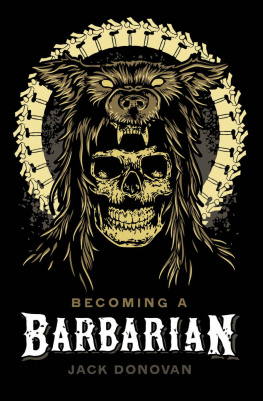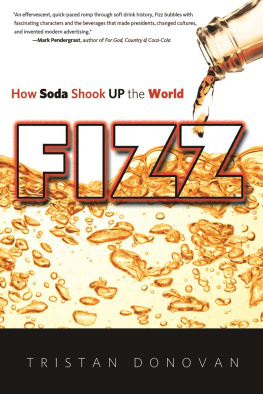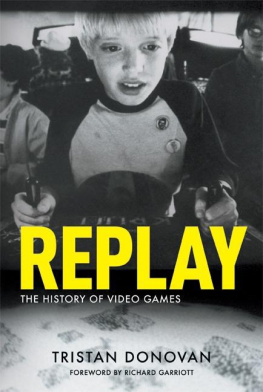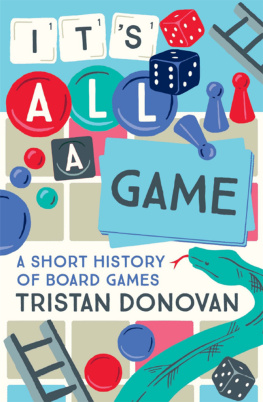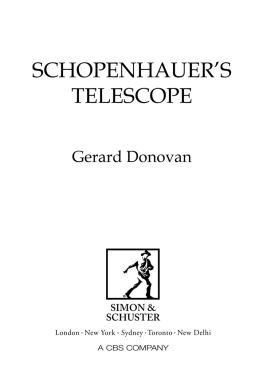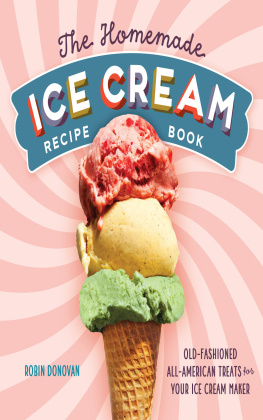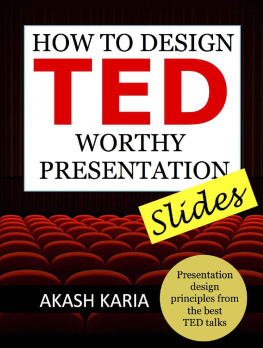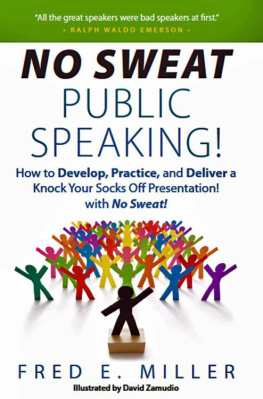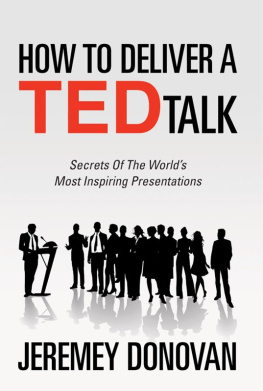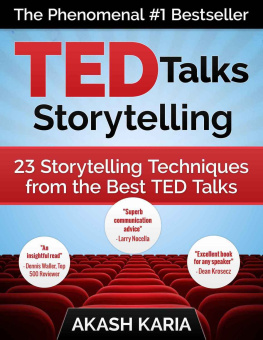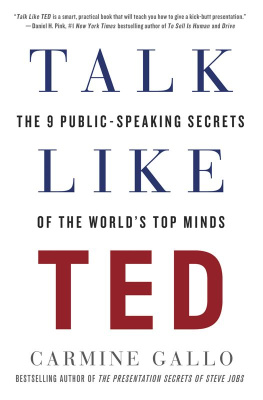
ACKNOWLEDGMENTS
At the November 2011 Toastmasters District 53 Fall Conference, I delivered an educational workshop entitled Step-by-Step Guide to Delivering Exceptional Keynote Presentations based on insights from my private study of TED Talks. I was shocked to discover there was surprisingly little cross-pollination between TED and Toastmasters. After the session, my Toastmasters friends gave me a mountain of constructive feedback and encouraged me to turn the workshop into a book. A few of the Toastmasters who have had a profound impact on this book include Joshua Reynolds, Grant DuBois, Nana Danso, Ryan Avery, Craig Valentine, Simone Morris, Sarah Goshman, Nicol Rupolo, Jane Shan, Eileen Murphy, and Tom Kobak.
A short, self-published version of this book was released on March 24, 2012. It was lovingly edited by my patient wife, Irene, who got much better grades than I did in English class. When I write, I define success as giving one copy to my daughter Emma and one to my son Ethan. When I gave Emma her copy, she said, Dad you wrote a pamphlet! Through nothing more than dumb luck, my 100-page pamphlet began to get traction in the speaking community and spread from there.
As I was sitting in a coffee shop on January 28, 2013 in New York City preparing to give my How to Deliver a TED Talk talk to a group of educators, I received the following message in LinkedIn:
Jeremey, I am President of Whimsy Literary Agency and I have an editor who is interested in picking up your book. Please contact me to discuss. Thanks. Jackie Meyer.
Though my scam detector was on high alert, I spent a half an hour researching Jackies background and quickly discovered that she is the real deal. Jackie became more than my agent; she is my trusted friend and advisor. With an hour to go before my presentation, I called Jackie, and she instantly connected me with McGraw-Hill editor Casey Ebro. Improbably, Casey agreed to come to the workshop I was holding that night. Though it may seem like a no-brainer, there are major trade-offs in moving from self-publishing to traditional publishing. I appreciate that few people are lucky enough to even have that choice. I made the decision because of my confidence in Casey; her unfathomable depth of knowledge about how people communicate convinced me that we could build a better book to inspire others to express their ideas worth spreading. I would like to come clean and admit that Jackie and Casey think I am a decent writer only because of PJ Dempseys expert proofreading and editing skills.
The biggest differences between a self-published work and a professionally published book are quality and marketing. I am indebted to the following individuals on the McGraw-Hill team for the magic they create behind the scenes: Chelsea Van der Gaag, Ann Pryor, Mary Glenn, Ron Martirano, and Janice Race.
Finally, I would like to express my appreciation to the TED Conferences organization and to the speakers who have inspired me with their messages and their delivery. In particular, I am grateful to Richard St. John, Simon Sinek, Daniel Pink, and Becky Blanton for unveiling the TED speaking experience that you cannot see in the auditoriums or on the videos. Additionally, my thanks go to the following speakers for generously granting their permission to me to publish quotes from their amazing TED Talks: Joe Smith, Jill Bolte Talylor, Matt Cutts, Bunker Roy, Susan Cain, Salman Khan, Ken Robinson, Elizabeth Gilbert, Cameron Russell, Deb Roy, Jamie Oliver, Regena Thomashauer, Hans Rosling, Ric Elias, Amanda Palmer, Jane Chen, and Bren Brown.
AFTERWORD
In order for our world to change for the better, great ideas need to spread. For ideas to spread, they must be easily understood. When they are easily understood, they become actionable. I wake up every day to inspire people to do the things that inspire them. We should strive to present our ideas in ways that will inspire others to join our movements or help champion our causes. The reason is simple; building something together is much more effective and more powerful than trying to build it alone.
When I speak, I never talk about things I do not understand or do not care about. I am not there to sell any products or services. If we do not care about the subject about which we are talking, then we should probably give a different talk. The more we care about the ideas we speak about, the more others will care about them too.
Before giving any talk, ask yourself, Why am I giving this talk? It is not enough to say you have invented something. It is not compelling to others simply to say you have a perspective on something you want to share. What is the reason you feel so compelled to give your message to others? What is so valuable that you would risk people disagreeing or even heckling you? What is so important that people should bother giving up any of their time to listen to you?
People often have the reasonably altruistic point of view, If they learn this, then it will increase their productivity or something like that. However, the best TED Talks are grounded in the more deeply personal mindset, I discovered or did something that dramatically changed my life. It was so powerful that I felt compelled to share it with others. Look at all of the 20 most viewed talks. Whether the speakers talk about their personal experience or not, the speeches are profoundly emotional for every single one of them. They either personally suffered or are intimately involved in whatever they are sharing. Watch Susan Cains talk, for example (a favorite of mine), to see this in action.
The talk I gave was born from something deeply personal. It came from the time when I hit rock bottom. I lost my passion for what I was doing. During the struggle that I went through to regain my passion, I made the discovery that the most successful people and organizations on the planet always function on the same three levelswhat we do, how we do it, and why we do it. The problem was that I only knew two of them. I knew what I did and was reasonably confident that I was good at it. I could explain how I was different from or better than my competition. But I could not say why I was doing it. My talk was not some commercial or academic exercise; it was an exercise to save myself. The discovery of this thing called The Why profoundly changed my life. I shared it with my friends because that is what we do when we find something beautifulwe share it with the people we love. My friends, in turn, invited me to share it with their friends. People kept inviting me to share and share and share. I just kept saying yes. Even though I do not tell that story in my TEDx Talk, the speech I gave most certainly began out of something deeply, deeply personal. In other words, I really cared about what I was talking about.
If anything, I think people need to know what their strengths are and stick to them. I try and put myself in positions that will allow for me to be successful. TEDxPugetSound was no exception. I had already been giving extended versions of my talk for a few years and I knew the content inside and out. Plus I had been immersed in the subject because the book I was writing, Start with Why, was nearing publication. I trusted that I knew the content well enough that I could talk about it without notes.
People put so much pressure on themselves when they have an opportunity to give a TED and TEDx Talk. And I understand why. I am fully aware how a successful talk can significantly boost ones career. Given the potential upside, too many people become preoccupied with the production details that they sometimes miss what really mattersthe message. I always remind people that the video and sound quality of my talk is pretty poor. And if that is not bad enough, while I was presenting, my wireless microphone failed and someone had to give me a new wired microphone. All of this was caught on camera. If your content is clear and well delivered, then people will overlook the production quality. If you panic because the wrong slide went up or your video did not play properly, the audience will also get distracted. For a talk to be successful, you must see yourself as the tour guide for an idea, not a stage manager for a production. And the best way to do that is to, again, focus on why you and the audience are there in the first place. Its not about you; its about your message.
Next page

